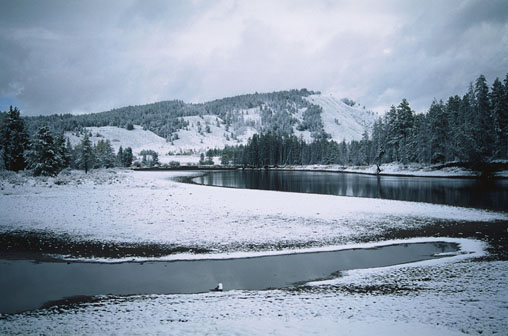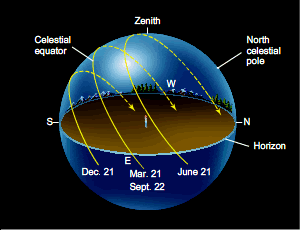Chapter 2. Seasons
2.1 Introduction

Author: Scott Miller, Pennsylvania State University
Editor: Grace L. Deming, University Of Maryland

The goals of this module: At the end, you should be able to:
- Explain why people living in the northern and southern hemispheres experience seasons.
- Determine where you would have to be located and on what day(s) to view Sun directly overhead at noon.
- Understand why the length of day varies over the course of the year.
- Explain the difference between more direct and less direct rays of light, and how they affect the seasons.
In this module you will explore:
- The apparent path of the Sun around Earth over the course of a day compared to the apparent path of the Sun around earth over the course of a year.
- The variation in the length of the daylight and directness of the Sun's rays over the course of a year due to the tilt of Earth's axis.
Why you are doing it: The Sun is arguably the most noticeable object in the sky, and its presence or absence in the sky determines day and night. It turns out that its position in the sky varies over the year as well, and a basic understanding of its apparent movement relative to Earth gives us an understanding of the cause of the seasons.

2.2 Background
The change of the seasons is one phenomenon that most people are familiar with, yet do not fully understand. At first, you may think that a change in seasons is caused by a change in distance of Earth from the Sun over the course of a year, but this is not so. If this were the case, then the entire Earth would experience the same seasons at the same time. You may have heard, though, that when we experience summer in North America, people in Australia (in the Southern Hemisphere) are experiencing winter.
If seasons are not caused by a changing distance between the Sun and Earth over time, then what does cause the changing seasons? It turns out that the seasons are due to the fact that Earth is tilted relative to its orbit around the Sun. In this activity you will discover for yourself exactly what effect Earth's tilt has on the seasons.
2.3 Earth is tilted
Earth revolves around the Sun in an elliptical, but near circular orbit. One common misconception is that it is the varying distance of Earth from the Sun which causes the seasons, but as you can see from this animation, the distance of Earth at aphelion (farthest approach from the Sun) is not much more than the distance of Earth at perihelion (closest approach to the Sun).
If we change our view of Earth's orbit such that we are looking at it from its side, rather than from overhead, we see that Earth's axis is tilted relative to its orbit around the Sun. While the tilt remains essentially fixed relative to the background stars, it changes relative to the Sun. Around June 21, the northern hemisphere is tilted towards the Sun while the southern hemisphere is tilted away from the Sun. Six months later, around December 21, the opposite is true and the southern hemisphere is tilted towards the Sun while the northern hemisphere is tilted away from the Sun.
If we ignore Earth's daily rotation for a moment, we can trace a circle around Earth (shown above in red) which represents the latitudes at which the Sun will be directly overhead throughout the year. Notice that it is not coincident with the equator, but is inclined relative to it. In fact, it is inclined by the same amount that Earth is tilted, 23.5°. To view this - open the animation and change to "earth is static" and check the "view celestial sphere" checkbox.
Question 2.1
Wo9nk6xf0Eeo6fS0DRJS3f7QBhC+YSePTHY1up3KY9AbVrs5x84q61KPHyVpZ3w+hcqYHpHWiyVqllMJcU5wbKCrPndyYqOkJKAOv0/N05CdugndhYm+TEUUV058/SiB+qZNNnpCMFPokhG/mvmHRRwtY3lVhECflqJPnSQRyGXgORzsMICGb2XseWeX1+JHHly4g/YRPy1E/77G1DA0mE0gOpQ+DAouNW+HBbDIG61ntyoQ6tnOHXSpFMZ35PiOUzz7aIjXumDxvcne61GM1YpmbLyT6nQ13gnBvo88OWCFEqLxwtajUSwkXOPogKTuk31Pexyj9eLlIMLuQLpdcER5pntjWspoxZ4NKuJh9akncLld2oe4cMA1WCzWUqodKf6V1kpnukKV1LA0oeBnirEBqZYhAPJtc5MCkfiKSLkv1uulLpYBqo/SlYniO70gWJIaDC4+6MbP4kKDe76zkE7dJi83R0g9qlMWlnsCJz586Li8BjCstmpSJbXa87/xwGMLx3hybj5RW/UdZsiIaXbH2zAfcHyzFarYMYGBInWm7DBfexVjimXfb7+JkW8ZrrE+u6gPSR4EfaF3gwCWF5oT7kuOmG4AvLV3zXwL/3FaDypb3KCQw7mmKfRSmdrfMwjhEGaH7zMzg21Fb9y+ybcnPU8DvprU45lRKI+9Dy9DQ9y9qvXhTYVadtb/7XBrZYHVOBQiV3YcjUTYinytkcJDY3l+Xlg0RPIZGcJ9xoasKYk7X7Q4SH2/6rrPBPPOggglk889NxozT5Jp2qnV4riaPqW5ZI7kikI2AKXQ+uhZHS1UQ3dnWSEmX+0n016Cxz5ocS3u8l5lPeckgh02JBUnqEtWG4jPngtu+4XTj4kZIUVO9454VvhqRLjYDUJyY+D6jpgPybcQ2fkmD54ec9bGgTYeVpdbe5qj9vsXhe6jRsphU4o2a/hgCHT8P/2efaaocjVGSAKJqnrgXwjn0r0sYryyvv/NhRn/5zmvp3xzfRoGDLSdetjaVuAu0AaxarbI/UZezPhUJyuYXNGhvEDyEi4AI+hWpEaEb0I9CYvKlDjYPKeYF0/lvO1hN8f+2.4 The Ecliptic
We can project Earth's equator and the apparent path of the Sun over a year onto an imaginary sphere surrounding Earth which astronomers call a celestial sphere. The projection of Earth's equator onto the celestial sphere is called the celestial equator, and the projection of the Sun's apparent path over a year is called the ecliptic. Watch the animation, select "earth is static", and check "view celestial sphere", then select pause and put in the equinoxes and solstices and observe the sun's position
As the Sun appears to travel along the ecliptic, its position relative to the celestial equator changes. You can see that the ecliptic crosses the celestial equator twice. These points are known as the equinoxes (vernal and autumnal). They occur twice a year, around March 21 and September 22, respectively.
Question Sequence
Question 2.2
cDi97yEpGekzvtaidEFyO8zpxJiRwtZeqJD5TrVVhDVzX0Fge0ZxpJ3nrOoFuHTkea8ksPIOsJgOPRIaNzg6PpWI3801fvIYxvShounxod5L+pGc5sApBlAajKS/NnJdGmrX0QTTgX30y+DJWGgUGhGVTtA7R6WJIAS0dwifPuSI6emHhxW3E0L11tkPuBGqyCaLg3rQnWfq6h9vW2CdogUFVkby98Zde9K1mvFDMNkR8sXikwP/PWbFWmgw2MkFiO9S8DjX3zB8FdkJDJP9TjMJeMF36Ah8cnBFwGBSSTW7fUJiLuuFGXTUmz8Z3Fkyt1Z3uCQzLAgAKeiJJgXZGTCHlzCTpoAM29VnjoKKQv4wuTv+PEKPDWv+sRSzQTT7RFZ7ci3PtvMBRjT+SE0y52DmSyCYjzC4pzO7TTV1SsjZvNL0TmvNoqr4+GLn44WryrZw4Sgj1+tqyrctY08rnS0dz9FGrr4KrIUuK2AGYNk+Rx8tqRMMbaETprOsLQAPehb34YPle0ei5ODAgJOvgL4RiGnWkkwxR72x5aqO3tmGTejG5rmj2initzKslVUSJDRoLOIVhHZA7i/fa99CirLalrkyWYtIA/NaXU4ff564jvxzKK34wj9P4crQIvancMdzRYPS8VIrbn7j0fHtN+/a7II=Question 2.3
Since the ecliptic crosses the celestial equator, this means that for half of the year, the Sun appears above north of the equator, and for half of the year, it appears above south of the equator. The dates when the Sun appears furthest north or south are known as solstices(summer and winter). They occur twice a year as well, around June 21 and December 21, respectively.
73O6hDEnQi+m/fHkJJW9lFXDXMAw1OFC5NUFIwv5PTCOJonhTOkEjKuWlDJI9y3tb+GGVtW3xVIHnv36lNGIxlwanMdUo4bWShKPy8OGaq+atyGVc0K+MIVN73S4GoCndMJ5LraGM0YnmO9irVvVEoFvlVHbhZt/y97kF09MAUD9iMZ8Zi/W7+fOf4bKhBcIf1KduNxhh02QafJYdRvhCgHLGkmspgzt47hFrn/0QY8kM20F48OfR508ZT7Ric9YtgkQSmkwINVQcY9q40bz4IwoF/oCphxSaYECswUMLR0oWN3Mg9ICLnXfejzC74VhxjqCS24g32NZmB7ej7qRoa6jeBa7HjcMoWCcMzR4JkQDksutR5yFbWBTcbK9P3mJD2zal4dyGokKZOrByDnbHpSSl9q5eUamA8a+ZLXxDueI40BR8xv5lV16QvZtTLPabZpzHTldLlSsb/k39W/BZYfj2SkduEdGySLJpk4dxaJA+nTnK+Lp2WHMinohW8Hi6bdwWdk0NvppDyPcjNq+8tzv2mW5J9s1hZ+oxFpZeCZWSmLsTjhFpXuuNs5db3HAkAOtDgMR8tHERejn2xQn7zhgluevShSs+lCYQ/7XZCBug6CY9ysa2nwVNBLEmwjfBG7owyP1OAEcoQdT/+DCmwY0sX12e+b84Nf1M0QPKCVdFotQgrj4isxVv0bziDgfJQMbgJgTN6soS/R7ldwMOlA29aSDp/fCZnwq0f7MQLdj7sjZ4/PMz2Uf63CJv0VS6LFu3XNpu43It+2tYoZOm1LYezl96gz8Tl9BB18MSS/i0G7TC2QIPuGxL7+kPAMeW6jER/cejazLG7bm3TNOok9e1TTpiuq46QtG0co3ujZFF7clXXZcVeLgasA=2.5 The length of the day
As you can see, the daily path of the Sun differs over the course of a year. We will examine three particular paths; the Sun's daily path on the Summer Solstice, June 21 (when the Sun is the farthest north above the celestial equator), the Sun's daily path on the Autumnal Equinox, September 22 (when the Sun is directly on the celestial equator), and the Sun's daily path on the Winter Solstice, December 21 (when the Sun is the farthest south below the celestial equator). On March 21, the Vernal Equinox, the Sun moves on the same path as on the Autumnal Equinox.
Check "Pause", select "Geosynchronic" view, check "View celestial sphere" and "View horizon", change speed to "minute per frame", press the "Summer Solstice" button and finally uncheck "Pause". Then investigate the Sun's motion on the equinoxes and winter solstice.
As we move from a space-based view to an Earth-based view, you can see the path the Sun will trace out on the three separate days for someone living at 35°N latitude. In each case, the Sun completes one full circle in 24 hours, but Earth blocks our view of the Sun when it is below our horizon. Therefore, the length of a day (the time the Sun is above the horizon) depends on what portion of the Sun's path is above the horizon.
Question 2.4
hVY1OL6EWYJ8Qr0KT7q8wxApaLBPRtmdylZrcv6CJaIGI1twHXmSAgI/nklg2b3Iha13fCqeYJjHKuGF151qYwQVaQr2srdoX6W1OHy9EMbyTbs/lgxN1v1Fvzus1ULDwggnB5ZArpVP4xEFUr24cO4OCVJMjNh0Vx77sbjXIdPgGjdjjYAbXMAUo3n8GV0Uee4PdtS7qO28wDCxgDXpkNYvqy5kkJ77EE86cpcJ8yB3enpiwFQF6V9Q/v35Rsvm8SYswGieJtnl3PYuyYza5h5CGN7LJpV98bCnhY2POrMZ3jZvVlJsA6f5u+96z5deEn8uQjFu2XaO/HwzFihCnntYbnpXaw3PaKtxAFlTNkA=2.6 The Arctic and Antarctic circles
We've seen the apparent path of the Sun on the three dates previously discussed for a person living at a latitude of 35° N. People at other latitudes will observe the Sun move across the sky along different apparent paths depending on their latitude.
Keeping in mind your answer to the question on the previous page, and the relative length of days throughout the year for someone living at 35° N latitude, check "Pause", select "Geosynchronic" view, check "View celestial sphere" and "View horizon", change speed to "minute per frame", press the "Summer Solstice" button and finally uncheck "Pause". Change latitude, begin at the North Pole and work your way south. Then investigate the Sun's motion on the equinoxes and winter solstice.
Question Sequence
Question 2.5
naaYswLE8cSqC4PqNBT8SZ1NVB4vSPcRcsaKiiGiZIrm+vEmji6kex9Pmhx6H74WI+W4NLonkk/HaJUS8k+QfRw5QZR9fSwR2M/EaeunhqO0f1lNI7yzXiwbmMxlNM5eerFWkJDS+2UYOYaJ3WgqzLUVSmclMOCwhuqLI38m4GoRDBUFCxqWGhi09YlPu5IBDy3SABRh50JCSKGLO7wMYaL32o2V+VsI9vssCPdgtutU9u1pv+SJZip0BNPvfOKGcGECBorsv+/Dh2t1wNGcGpHQarlhx4qL3IPYSpAm+kd6wkD5p37LM7TSnOSDNZaiBgAVXcNjqqcEw0/u6mzlBaJfQmPkeBzbdYwaaPIw8Fz3h/FAbGja4R9sEBgMzAV/gQPOearsImqP47gZ6/4bXze2ManFu5/JX32eJKayS9ZIDvn9tksD0Nt/k4sDue9T/6pbGn1AdB0LPN/6H7Q9q9sc59Lj3ZES7oHR8xUMRwu6oGem0lTouQ1HuuZ0rI2Mdh8Vl5esz0izJh2xx/m1GlA4vxwFy/LYV9pHJDWXjieze5prFOCnM8Qy/itIs0YENVpPB9KSm0uv8EQmfMpeeNs6Mi5qtTXu8GbZavgHAho4kRlNtEhA3QLdpBR+UiK3g1jntpscaYCJLElgyamDLKMvtYlf9av8DUONnN0bSXywtUBvTiwLFawdalXNl1xC82ggzYcAXwUHBbLDTe6wd7dEn5MYpdO5QwuvShlC3Owy3cdp/p777rO53Kr2nNHBrF+AbKIfAx7iRuIumco4pfiIqQ9TDyBpL99p+f2PDokzgroY8imRvg==Correct. This latitude is known as the Arctic Circle. At this latitude and higher the region experiences 24 hours of daylight on June 21 and 24 hours of darkness on December 21.
Question 2.6
b/ccoUjvENyVOf5GcdnRTPXjTCQuKVImcIToucBlWC88hdP37gaSZe2ITkRdKdM7D47sQJi3u2WEHtEgxZc6i3VPUnH5hOZ9dEBUGYDck9XwlYph0Wl5FoCjF+uq4hYuAwy+7pDCGRmJOfuly1s8vU4dToXK13ERdtoYGxQMDmuy6yA0s+51UMRAnp0cbspIDaR31mQRrwgRklivq5fWh9RvCTv7Hitasq14U0Pq7AYs9qoiAn0f+tKYIX10oHg04uMisLL85vh9Nd5rdcBoSNrKk4mUtxH+l9+mUo6Rp/vUpCsT/vVIsplVwNlIQZWtppNTUUGj9yCgz0Ap/bDveFSFZuLPAdpr1+ETZU2IVaoXektwyxnEQbeNwKgA+mdfPpFlajRHAQRRWRU+VW9aBYCJ+gVaR1o8yLKPgtZ5gmL7GgIi+QGSgofLEWy+IXHOW2hdMHFSiRHGm6nhIHLXhpZHuHRYuWoW6oezH3+W4ccWOyGPj9gPspKQzKTnMn7p09CJoC0UdK+LsYyKDm3HU6iNn01Xi3gOTgChzr3MBY+TX+/XUOweIk9eFqx9wdAmcnLaWCzs+t1yKgyB/sCJLWiSlDoqk5j+vuXRdLs5WRfpkn6ntk6/hk4Ri89gh6lShsrnuKKBYik8CcQRBcApdcsqF5qE3SAgLZmWMxCvPOutR80lkPdBhO8cFLqnhouIMOGCIlRWQ6Q4DgwXOMs+3Cp24QTuSl+gJBprCo1t6kPCASWLLHQZWFIvb7EKwZF/ycf6QaBFA9+aenP/4ye6h4YQ5veNckJIgvnX7FHWNFF9cNMBSgRGOBroRnA+xENvCorrect. This latitude is known as the Antarctic Circle. At this latitude and south of it the region experiences 24 hours of daylight on December 21 and 24 hours of darkness on June 21.
Question 2.7
zs2ljKJn0rV7NggMIFj+N4/f2jlgse2uDd4jkXzNTB0kV9BCpqmFQIjTziQWhIsxdq9uK4N/6fayn2bkpQCJuEd47pRU2CUNo7bZN3Y0M3PwNDrFhj857EBp6/ge7Spztj03RlaZNOSBGPBGN4x4XVql3cANBhEuHsHe14Xgk/CJlN78eGOVW3hlU9wNvpqFw5j8aMYc53Ttx/x4wIyRwMkzfCyjcTRt4tZqpuhhw9CadHM3BHtmuhBfljGnq4YsuV6XtpZgLPBy1gVTC9Usv8yvfIbP6F4GZjzThswdn1ilKd2GftY0JzjXHC2A7jc4KThnYWV0udrJnmtWHVMQeCR7FOUl6/2BUjydPqV3vSDmd7rQniSBVXaLxH7+kgU83RGh1s2JsKgeOYXGjLfNKh8UhZYYCBBEam1D/ZRZ5G5bIvpSqvC+HPNIrkGQJ+WaYYyd6QsKcbu6OnYOyZYllSjmz6MXxDdwieRPCyhO22qlGMRepAB3HBNajjxeDzZmc225HXWYXuD0yXXRoB3sNJti2sJK/kB6H1KrXcXoiTsXIL4600Le6QCSOIlkZqShz3e0N1FKpmEVxnzoF9LtoXNFtVtH/98yq/MOdSICUQE9Qg0qVLHFJKhSv41Rq36cQNJ52GPQvBHtV+lDbMbkuhg+c3L3qIpBJbhuq/wh/WZTY17GsbsJmpFsoFGHlwt2h1doYQ==Correct. The lengths of days are reversed for people in the southern hemisphere, compared to people in the northern hemisphere.
Question 2.8

As you change from one latitude to another, not only should you notice that the length of day varies based on latitude and day of the year, but the position of sunrise and sunset also varies.
5o1YTyJg10Uj8pxniKchm529pm6VgJzj8mQEuy8Is/2Eg9K9dCJ4KJWtYDaN5YbhUUohFFl4rniEcz1QKZeC7kAm10BcrNuEGDKb2mRo1NHqcvY4QdAQybPc7BqN5Ka+WJ457cRkl6RcTMkT342XAhaNoFnK2H9bSSqXXP4n7KwgMPUd+6Om4VTA/ZGSxQ5hqAXs50EGN8r1iTK4lo3n07CGSoZBsm9w8B/JpqjBvYGSt9Mxkr9WL/wz4DbwkQ6mXsI79HGmXQhofsZOy8cvk0pkic0ibUGSd2o2rfzO1LEFCwz1EoAVRF1G5UE/PGV6vBnMl9HXfsw58rvxZtS7jHMoGN0OoBcH/ySNR75iW3Hzy9Ev8yGtsvVBWQMW/Tb+otOIt/4swmFeRQoJqDkq0EpeJ13jQkNaqzk252TWvpWR5vg2sHcPy71iyjSR7glr40/gw2flm9GJxAWGetyS/lAez2v+2nTOCorrect. At all latitudes, the Sun rises exactly due east and sets exactly due west on the equinoxes.
2.7 Heating the Earth

We've all heard the phrase "the Sun rises in the east and sets in the west.", but as you learned above, that's not exactly true. On the day of the equinoxes, when the Sun is directly above the equator, the Sun does rise exactly due east and set exactly due west, but that's it. In the Northern Hemisphere, between March 21 and September 22, the Sun rises north of east and sets north of west, and between September 22 and March 21, the Sun rises south of east and sets south of west. Feel free to play around with the animation again to demonstrate this for yourself.
Let's go back to 35° N latitude. Again we can see the range over which the Sun appears to move over the course of a year. Let's focus now on the Sun's position at noon. For a person at 35° N latitude at noon, the Sun will always be due south (Do you remember why it will never be overhead?) On June 21 the Sun will be very high in the sky at noon while on December 21 the Sun, even at noon, will be low in the sky. The directness of the Sun's rays will vary with the height of the Sun.
Change the apparent angle of the sun in the animation below. Watch what happens to a single ray of light as the angle changes.
Question Sequence
Question 2.9
U8fmA27pDoZWAMmAt7vJc8rTfEHQ4zRThoP1WxwEtE5kY9jYNHg5xplb5XadipY3fBg/aAgaEIcL01ObQRobXfC9M1L0PvHfme3BJWHUVBdYpDx6LK36IN/bpM2ONVrhje9LDJ6RKJRUItCe1rcd/CxEHLv0gXEr7BYtQ5oVH2PHA54F9z8vA94uPsMSfIBVSmlOtWFzkr363PzzmA2rb69yBOx94lL17lf30O/A5zaQsEhcfkw3ssKtQaPuFclVGNTM7mSwX31UJ0+RTnJ69HCLLbKC4gRTi2wPkEVqnDzOYR6G+mpJ7haHpPKAa75zIAysRUEurkdoA9gD8A/8ZZkzAXXPjEYdLqsRDUWULwD+I/uF+gr8tXSq3yVGOSQcNr9pYPAOav5jw4z/Vf+p3Lvzjwkix4fPcyGvCEMKN9Bfmj1ruMFvtQMBoRDcIVS8Question 2.10
AAHF9z0RGM03o9E0nhHSD+R07S/hC8EzY4CM8rS2ycvNyFnT9OGdF6bVYzIcjRZImqtx/naiydcFA8s7I+iODmCLum/goIRVyAwL43ZGew/heI16BN0+514MNZRJAoZuurjv7o4A5pRmp7bUY/7CxsL4dAGTCt9eWXNec3wAL1M0OfLLUcWqknC+5iiaxNYKnfSaArPlX2eCzfXOaGSMprrnUKbpZRAbTau03Gjj0TZTKEWoQTqVPU3+ZP/oETXoA3gcO3pDDIWAjDphKhHjWE83j8uzeeFNFUfpU7UNKoKo65DxR9dCWAOkCdgShcVcy2CIKD0JIXk4JaZvHz2PoO4YfUrEJI9ptLZgEA==Summary
Throughout the year, the Sun always gives off the same amount of energy, but how much it heats a particular part of Earth's surface depends on how directly it strikes the surface.
2.8 Quick Check Quiz
Indepth Activity: Seasons